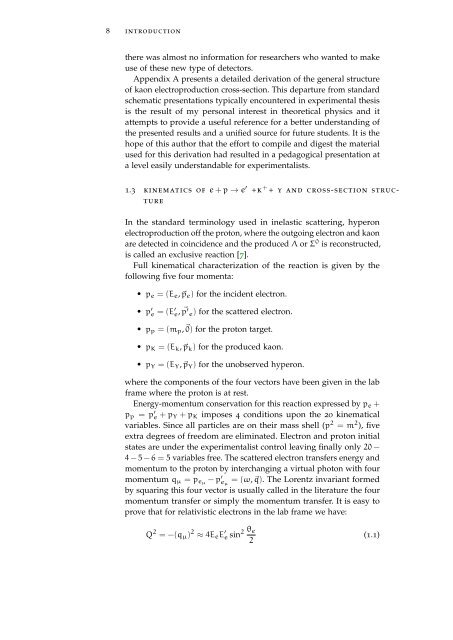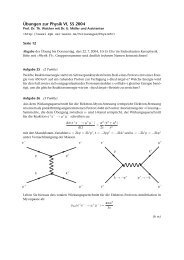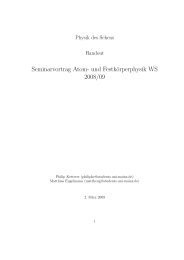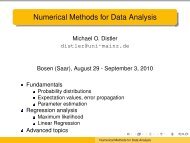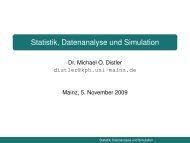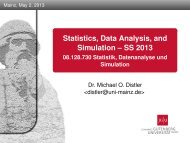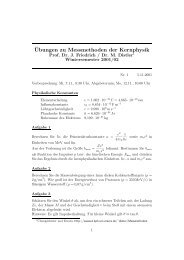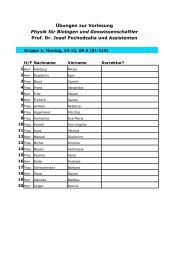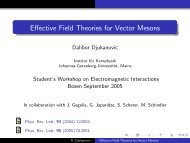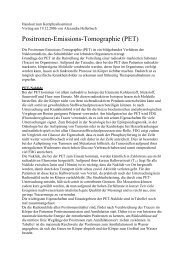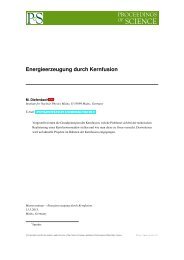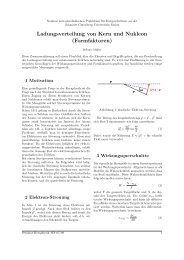A Classic Thesis Style - Johannes Gutenberg-Universität Mainz
A Classic Thesis Style - Johannes Gutenberg-Universität Mainz
A Classic Thesis Style - Johannes Gutenberg-Universität Mainz
You also want an ePaper? Increase the reach of your titles
YUMPU automatically turns print PDFs into web optimized ePapers that Google loves.
8 introduction<br />
there was almost no information for researchers who wanted to make<br />
use of these new type of detectors.<br />
Appendix A presents a detailed derivation of the general structure<br />
of kaon electroproduction cross-section. This departure from standard<br />
schematic presentations typically encountered in experimental thesis<br />
is the result of my personal interest in theoretical physics and it<br />
attempts to provide a useful reference for a better understanding of<br />
the presented results and a unified source for future students. It is the<br />
hope of this author that the effort to compile and digest the material<br />
used for this derivation had resulted in a pedagogical presentation at<br />
a level easily understandable for experimentalists.<br />
1.3 kinematics of e + p → e ′ +k + + y and cross-section structure<br />
In the standard terminology used in inelastic scattering, hyperon<br />
electroproduction off the proton, where the outgoing electron and kaon<br />
are detected in coincidence and the produced Λ or Σ 0 is reconstructed,<br />
is called an exclusive reaction [7].<br />
Full kinematical characterization of the reaction is given by the<br />
following five four momenta:<br />
• pe = (Ee, �pe) for the incident electron.<br />
• p ′ e = (E ′ e, �p ′ e) for the scattered electron.<br />
• pp = (mp,�0) for the proton target.<br />
• pK = (Ek, �pk) for the produced kaon.<br />
• pY = (EY, �pY) for the unobserved hyperon.<br />
where the components of the four vectors have been given in the lab<br />
frame where the proton is at rest.<br />
Energy-momentum conservation for this reaction expressed by pe +<br />
pp = p ′ e + pY + pK imposes 4 conditions upon the 20 kinematical<br />
variables. Since all particles are on their mass shell (p 2 = m 2 ), five<br />
extra degrees of freedom are eliminated. Electron and proton initial<br />
states are under the experimentalist control leaving finally only 20 −<br />
4 − 5 − 6 = 5 variables free. The scattered electron transfers energy and<br />
momentum to the proton by interchanging a virtual photon with four<br />
momentum qµ = peµ − p′ eµ = (ω, �q). The Lorentz invariant formed<br />
by squaring this four vector is usually called in the literature the four<br />
momentum transfer or simply the momentum transfer. It is easy to<br />
prove that for relativistic electrons in the lab frame we have:<br />
Q 2 = −(qµ) 2 ≈ 4EeE ′ 2 θe<br />
e sin<br />
2<br />
(1.1)


